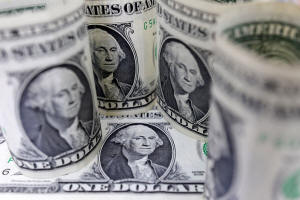Morning Bid: Dollar flexes again, Japan warns
 Send a link to a friend
Send a link to a friend
 [March 27, 2024] A
look at the day ahead in U.S. and global markets from Mike Dolan [March 27, 2024] A
look at the day ahead in U.S. and global markets from Mike Dolan
The U.S. dollar is flexing muscle yet again as the first quarter grinds
to a close, surging anew on Wednesday against Japan's yen, the Swiss
franc and China's yuan - and drawing stern warnings from Japanese
government officials in the process.
The dollar/yen exchange rate hit a 34-year high just a whisker from 152
overnight -- surpassing previous peaks from 2022 that drew intervention
from the Bank of the Japan at the time. The dollar has now jumped almost
20% against the yen since the beginning of last year.
Clearly monitoring the yen's slide in real time, Japan's finance
minister Shunichi Suzuki issued his strongest warning to date in the
current episode and said the authorities could take "decisive steps" - a
phrase previously used in Autumn 2022 just before Japan stepped in to
sell dollars on the open market.
What irks Japanese officials most is the fact the yen's fall has
accelerated even after the Bank of Japan has started to normalise its
super-loose monetary policy - prompting speculation the central bank may
have to move faster on that score regardless of any currency market
steps.
And of course Japanese stocks lapped up the weaker currency as an
additional export fillip, with the Nikkei benchmark jumping almost 1% on
Wednesday.
The weakening yen tends to pressure other competing Asia currencies, not
least China's yuan - which also fell again earlier.

Unlike the Nikkei, Chinese stocks got no solace from the currency move,
however, and recoiled to near one-month lows.
Even though data showed Chinese industrial profits picked up at the
start of the year, political tensions and property sector worries have
seen foreign investors continue to exit the market - with almost a $1
billion sold again on Wednesday via the Stock Connect system, the
biggest outflow since mid-January.
China's President Xi Jinping met with American business leaders at the
Great Hall of the People in Beijing as the government tries to woo
foreign investors back to the country and international firms seek
reassurance over new regulations.
But the dollar is pumped up more generally - lifted by slightly more
hawkish Federal Reserve noises on the trajectory for policy rates
through next year and beyond.
Above-forecast U.S. durable goods orders data on Tuesday bolstered the
view of a robust economy, while business spending on equipment showed
tentative signs of recovery and consumer confidence held steady.
With the Swiss National Bank having jumped the gun on its major central
banking peers last week by cutting interest rates, the Swiss franc leads
the way lower against the dollar in Europe and hit its weakest point
since November 3 last year.

[to top of second column] |

U.S. Dollar banknotes are seen in this illustration taken July 17,
2022. REUTERS/Dado Ruvic/Illustration/File Photo

A growing feeling that other European central banks may move to ease
ahead of the Fed has put every central bank meeting under the
microscope.
Sweden's crown touched its weakest levels of the year against both
the dollar and euro on Wednesday after the Riksbank, Sweden's
central bank, held its key rate steady at 4% but said inflationary
pressures had eased enough for it to make the first of several
policy rate cuts in the coming months.
The European Central Bank, meantime, is increasingly confident that
inflation will fall back to its 2% target by mid-2025 as wage growth
moderates, strengthening the case for lower interest rates, ECB
board member Piero Cipollone said.
European stocks were marginally higher on the day, although oil and
gas shares there were the biggest drag on the index as crude oil
prices ebbed on rising U.S. crude inventories and signs Russia is
struggling to get payment for oil shipments amid sanctions threats
on related banking flows.
Back on Wall St, the downbeat start to the week for stocks continued
on Tuesday - but futures were positive again ahead of Wednesday's
bell. Treasury yields were flat.
In politics, much of the focus on Tuesday was on how shares of
Donald Trump's Trump Media & Technology Group surged as much as 59%
in their Nasdaq debut, lifted by the former U.S. president's
supporters and providing him a potential windfall as he grapples
with the costs of several legal cases.
But the latest opinion poll trackers show President Joe Biden's
approval ratings among American voters picking up in March to their
best levels of the year so far.
Key diary items that may provide direction to U.S. markets later on
Wednesday:
* Federal Reserve Board Governor Christopher Waller speaks, Swiss
National Bank Vice Chairman Martin Schlegel speaks
* South Africa Reserve Bank policy decision

* US corporate earnings: Cintas, Carnival, Paychex
* US Treasury sells 7-year notes, 2-year floating rate notes
* Dutch Prime Minister Mark Rutte meets Chinese President Xi Jinping
in Beijing; Brazil President Luiz Inacio Lula da Silva meets French
President Emmanuel Macron in Rio de Janeiro
(By Mike Dolan, editing by Christina Fincher, mike.dolan@thomsonreuters.com)
[© 2024 Thomson Reuters. All rights
reserved.]
This material may not be published,
broadcast, rewritten or redistributed.
Thompson Reuters is solely responsible for this content. |